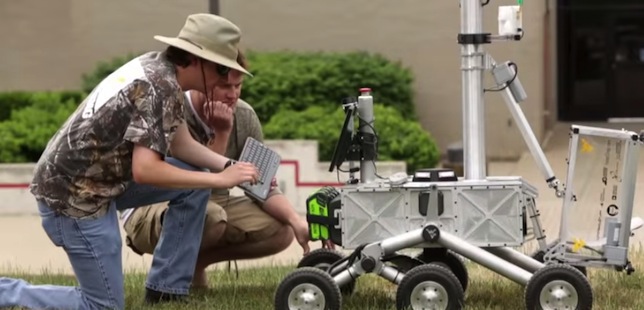West Virginia U Engineering Students Grab NASA Robotics Challenge Prize
- By Dian Schaffhauser
- 06/15/15
A team of engineering students from West Virginia University has taken home a $100,000
prize from NASA in a
"Sample Return Robot Challenge," part of
the space agency's Centennial Challenges prize
program. This contest was in its fourth year of operation, and this team was the first to take prize money home for this specific challenge.
The event took place in a 20-acre field at Worcester Polytechnic Institute in Massachusetts
during a festival of science, technology and robots being hosted there.
The objective of the overall challenge was to encourage innovation in autonomous navigation and robotics technologies. The competition
required teams to demonstrate that their robots could, without human control, locate and collect geologic samples from various terrains. There
were two levels. To succeed in level one, the robot had to depart from a starting platform in search of a sample, the specifications of which
were previously programmed into the robot's onboard computer. Operating autonomously, the robot had 30 minutes to locate samples, collect them
and return to the starting platform without damaging at least one sample.

Teams that succeeded were invited to move to level two. Only two teams made it that far: West Virginia's Mountaineers (named after the
school's mascot) and "Survey," a Los Angeles team made up of three engineering professionals.
In that phase of the competition, robots ran autonomously and had two hours to return at least two undamaged samples, one previously known
to the team and the other introduced the day of the competition. These samples were categorized as easy, intermediate and hard based on the
complexity of the objects' shapes, sizes and designs. More points were awarded for those classified as hard.
West Virginia's robot, "Cataglyphis" collected two samples to be named winner. The robot is named after a type of desert ant known for its
ability to journey away from its nest in seemingly random directions in search of food and reliably return on a direct path home as quickly as
possible.
The winners spent 18 months — 100 hours per week — working on the robot. "Last year, we learned how to put this together and learned what
tools were essential to successfully build the robot. This year, we built those tools and used them in the most efficient manner," said team
member Jared Strader, a graduate student in mechanical and aerospace engineering,
in a prepared statement. "We knew the difficulty level was going to increase significantly this year, so it is the best feeling for us to go
out there and accomplish what we set out to do."
According to Monsi Roman, program director of the NASA challenges and a chief microbiologist for the space agency, the winners "combined the
smarts from the software, mechanical and electrical parts of their system. But most importantly, they won because they worked collaboratively
and had a very strong project management team to guide them."
The 16 members of the team were led by Yu Gu, an assistant professor of mechanical and aerospace engineering at the university. "I just
mentored them," he emphasized. "They did all the hard work and brought home the victory. They were the ones who programmed, researched and
thought all this through. It's exciting to see it pay off for them."
The prize money may be used, the team added, as seed funds for scholarships for engineering students to perpetuate the program.
NASA Centennial Challenges started in 2005 as a way to get the public involved in advanced technology development. The program offers
incentive prizes to generate innovative answers to problems of interest to NASA. Competitors receive no government funding support, and awards
are only given when the challenges are met.
About the Author
Dian Schaffhauser is a former senior contributing editor for 1105 Media's education publications THE Journal, Campus Technology and Spaces4Learning.